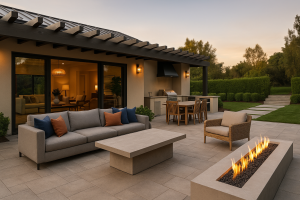Choosing the right roofing material for your home or building is a crucial decision that can impact the longevity and performance of your roof. With so many options available, it’s essential to understand the factors that affect roof longevity and which types of roofs last the longest.
In this article, we will explore the durability and lifespan of different roofing materials, including asphalt shingles, metal roofing, clay and concrete tiles, slate roofing, and wood shakes and shingles. We will also discuss the factors that contribute to a long-lasting roof, such as proper installation, quality materials, climate conditions, and regular maintenance.
Factors Affecting Roof Longevity
While the type of roofing material is a significant factor in determining the lifespan of a roof, there are several other essential factors to consider:
Proper Installation
Proper installation is crucial for the longevity of a roof. If a roof is not installed correctly, it could result in leaks, poor ventilation, and other issues that could significantly reduce its lifespan. Hiring a professional roofing contractor with experience in the specific type of roofing material is essential.
Quality of Materials Used
The quality of materials used for roofing plays a critical role in determining its lifespan. High-quality materials will last longer and require less maintenance. Choosing materials from reputable manufacturers will ensure that they meet industry standards and offer reliable performance over the years.
Climate Conditions
The climate in which a roof is located significantly affects its longevity. For example, extreme weather conditions, such as hail, wind, and heavy rain, can impact the lifespan of a roof. Regular inspections are necessary to identify and address any damage caused by harsh weather conditions.
Regular Maintenance
Regular maintenance is essential for the longevity of a roof. Regular inspections, cleaning, and repairs are necessary to ensure that the roof is functioning correctly and that any issues are addressed promptly. Neglecting maintenance can significantly reduce the lifespan of a roof.
Asphalt Shingles
Asphalt shingles are by far the most popular roofing material in North America. They are affordable, easy to install, and come in a wide variety of colors and styles to suit different architectural styles. However, their lifespan is relatively shorter compared to other roofing materials.
On average, asphalt shingles last between 15 to 30 years, depending on the quality of the shingles and the climate conditions in the area. Regular maintenance, such as cleaning debris off the roof, repairing damaged shingles, and ensuring proper ventilation, can help extend their lifespan.
Pros of Asphalt Shingles
| Advantages | Explanation |
|---|---|
| Affordability | Asphalt shingles are one of the most affordable roofing options available, making them a popular choice for homeowners on a budget. |
| Easy installation | Asphalt shingles are relatively lightweight and easy to install, making them a popular choice for both DIY and professional roofers. |
| Wide variety of colors/styles | Asphalt shingles come in a broad range of colors and styles, making it possible to find a look that complements your home’s design. |
Cons of Asphalt Shingles
| Disadvantages | Explanation |
|---|---|
| Shorter lifespan | Asphalt shingles have a relatively shorter lifespan compared to other roofing materials, such as metal and slate. |
| Not as durable | Asphalt shingles are more prone to damage from wind, hail, and other weather elements, which can result in the need for more frequent repairs and replacements. |
| Environmental impact | Asphalt shingles are petroleum-based products, which means they have a significant environmental impact both during the manufacturing process and after their useful life is over. |
Overall, asphalt shingles are a popular choice for many homeowners due to their affordability and ease of installation. However, they may not be the best choice for those looking for a long-lasting roofing material.
Metal Roofing
Metal roofing has gained popularity in recent years due to its durability and long lifespan. Metal roofs are available in several materials, including aluminum, copper, zinc, and steel. Each metal material has its unique characteristics and lifespan.
| Metal Material | Average Lifespan |
|---|---|
| Aluminum | 40-50 years |
| Copper | 50+ years |
| Zinc | 50+ years |
| Steel | 30-50 years |
Metal roofs are durable and resistant to fire, rot, and insect damage. They can withstand extreme weather conditions, including high winds and heavy rain. However, metal roofs can be prone to damage from hail and fallen branches. Regular inspection and maintenance can help identify and repair any damage to the roof.
Proper installation is crucial for the longevity of metal roofs. Improper installation can lead to leaks and premature aging. Metal roofs should only be installed by experienced professionals. Regular maintenance, including cleaning and coating, can also prolong the lifespan of metal roofs.
Types of Metal Roofs
There are several types of metal roofs available, each with its unique characteristics and lifespan. The most common types include:
- Standing seam metal roof
- Metal shingles
- Corrugated metal roof
- Ribbed metal panels
The choice of metal roof depends on the style of the home, climate conditions, and personal preference. Standing seam metal roofs are popular due to their sleek design and durability. Metal shingles can mimic the look of traditional roofing materials, such as asphalt shingles and wood shakes.
In summary, metal roofing is a long-lasting and durable roofing material. With proper installation and regular maintenance, metal roofs can last up to 50 years or more.
Clay and Concrete Tiles
Clay and concrete tiles are popular roofing materials known for their durability and resistance to weather elements. They are great options for homeowners looking for long-lasting roofing materials.
Pros of Clay and Concrete Tiles
Clay and concrete tiles have a long lifespan, ranging from 50 to 100 years, depending on the quality of the installation and maintenance. They are resistant to fire, insects, and rot, making them popular in areas with harsh weather conditions. They also add unique aesthetic value to homes, adding to the overall curb appeal.
Cons of Clay and Concrete Tiles
Clay and concrete tiles have some disadvantages. They are quite heavy and can only be installed on homes that can support their weight. They may require extra support during installation, which can add to the cost of the roof. They can also crack or break if walked on or if heavy objects fall on them.
Installation and maintenance
Clay and concrete tile roofs should be installed by professionals to ensure their longevity. Regular maintenance is also necessary to ensure they last as long as possible. Gutters and downspouts should be kept clean to prevent water damage, and broken or cracked tiles should be replaced immediately.
Cost
Clay and concrete tiles are some of the most expensive roofing materials in the market. However, their long lifespan and durability make them a wise investment for homeowners in the long run.
Slate Roofing
Slate is a natural stone material that has been used as a roofing material for centuries. It is known for its exceptional durability and longevity, with some slate roofs lasting up to 100 years or more.
Benefits of Slate Roofing
The main benefit of slate roofing is its longevity. Slate is a highly durable material that can withstand extreme weather conditions, including heavy snow and hail. It is also fire-resistant and does not rot or decay like other roofing materials.
In addition to its durability, slate is also highly energy-efficient. It has natural insulating properties that help to keep homes cool in the summer and warm in the winter, reducing energy bills and improving overall comfort.
Lifespan of Slate Roofing
The average lifespan of a slate roof is between 75 and 100 years, although some slate roofs have been known to last even longer. The longevity of a slate roof is largely due to the fact that the material is so durable and requires very little maintenance.
However, it is important to note that proper installation is crucial to ensuring the longevity of a slate roof. Improper installation can cause the tiles to crack or slip, leading to leaks and other issues.
Installation and Maintenance
Because of the weight of slate tiles, installation requires special expertise and equipment. It is important to work with a professional roofing contractor who has experience with slate roofing to ensure that the installation is done correctly.
Once installed, slate roofing requires very little maintenance. Regular inspections are recommended to check for any cracked or broken tiles and to clear away any debris that may accumulate on the roof.
Wood Shakes and Shingles
Wood shakes and shingles are popular roofing materials known for their rustic and natural appeal. However, when it comes to longevity, they might not be the most practical option.
While a well-maintained wood roof can last up to 30 years, they are more susceptible to weather elements and require regular maintenance to avoid issues such as rot, mold, and insect damage.
| Pros | Cons |
|---|---|
| Visually appealing | Require regular maintenance |
| Available in a range of materials (cedar, redwood, pine) | More susceptible to weather elements (wind, rain, snow) |
| Not as durable as other roofing materials |
Before considering wood shakes or shingles for your roof, it’s essential to factor in the additional maintenance and repair costs to maintain its longevity.
Other Factors to Consider
In addition to the type of roofing materials, there are other factors that can impact the longevity of your roof. Here are some essential elements to consider:
- Insulation: Proper insulation can help regulate temperature and prevent moisture buildup, which can prolong the lifespan of your roof. Inspect your attic insulation regularly and add more if necessary.
- Ventilation: Good ventilation can also regulate temperature and moisture levels in your attic. Check your vents and ensure they are clear of debris, and consider installing additional vents if needed.
- Attic Ventilation: Proper attic ventilation can prevent ice dams from forming in winter and excessive heat in summer. Make sure your attic is well-ventilated to avoid damage to your roof and home interior.
- Regular Inspections: Regular roof inspections can identify potential issues before they become major problems. Hire a professional roofer to inspect your roof at least once a year or after severe weather events.
FAQ – Frequently Asked Questions
Here are some commonly asked questions about roofing materials and their longevity:
What is the average lifespan of a roof?
The average lifespan of a roof depends on several factors, such as the type of material used, installation quality, and maintenance. Asphalt shingles typically last between 15-30 years, metal roofs can last up to 50 years or more, and slate or tile roofs can last up to 100 years.
What factors affect the longevity of a roof?
The longevity of a roof can be affected by several factors. These include the quality of installation, the materials used, climate conditions, and regular maintenance. Proper installation and maintenance are critical to ensuring your roof lasts as long as possible.
Do different roofing materials have different lifespans?
Yes, different roofing materials have varying lifespans. For example, asphalt shingles typically last between 15-30 years, metal roofs can last up to 50 years or more, and slate or tile roofs can last up to 100 years. Proper installation and maintenance can also impact the longevity of a specific roofing material.
What are some maintenance tips to maximize the lifespan of a roof?
Maintaining your roof is crucial to ensure its longevity. Some maintenance tips to consider include regular inspections, cleaning debris and debris buildup, addressing any leaks or damage promptly, and ensuring proper insulation and ventilation.
How do environmental factors affect the lifespan of a roof?
Environmental factors such as extreme heat, cold, wind, and rain can impact the lifespan of a roof. For example, harsh weather conditions can cause asphalt shingles to deteriorate more quickly. Proper installation and maintenance can help mitigate the impacts of environmental factors.
Are warranties available for roofing materials?
Yes, warranties are often available for roofing materials. The length and coverage of a warranty can vary depending on the manufacturer and the specific product. It’s important to read and understand the terms of the warranty before making a purchase decision.
What factors should I consider when choosing a roofing material?
When selecting a roofing material, it’s essential to consider factors such as cost, lifespan, durability, maintenance requirements, and climate. It’s also important to work with a reputable and professional roofing contractor to ensure proper installation and maintenance.







